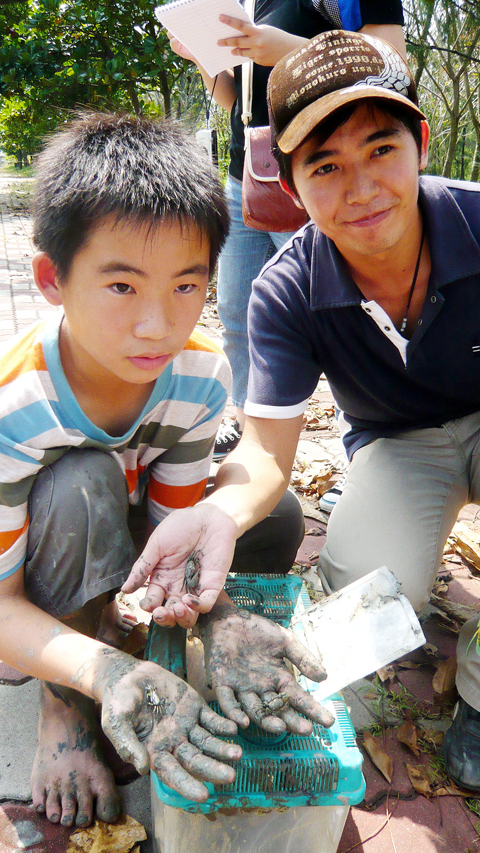The nation’s declining birth rate has dealt a death blow to a considerable number of small elementary schools over the past seven years.
Ministry of Education statistics showed that, in the past school year, there were 859 primary schools in the country that had only six classes per school.
A number of local governments, such as the Tainan and Chiayi county governments, have actively sought to close small primary schools in a bid to cut government expenditure.

PHOTO: FLORA WANG, TAIPEI TIMES
As many as 138 schools nationwide, particularly in remote areas in central and southern Taiwan, were shut down or merged with neighboring schools by local education bureaus between 2001 and the last academic year, ministry statistics show.
For the schools that remained, fighting for survival is an immediate concern.
Tainan County’s Shuangchun Elementary School faced the same problem other tiny schools did.
“We were informed two days after Tainan County Commissioner Su Huan-chih (蘇煥智) was re-elected [in 2005] that the school would be closed,” Wang Li-hui (王麗惠), director of the school’s academic and student affairs, said earlier this month.
The school was placed on the county government’s chopping board because it did not meet the new minimum student number — 60 students — set by the government in 2005.
However, the school was able to reverse its fate by emphasizing its unique character and promoting courses that made it irreplaceable.
The key to the school’s success was helping its students gain a better understanding of the neighborhood they live in.
Located between the mouths of Pachang Creek (八掌溪) and Jishuei River (急水溪), the school enjoys a rich ecology.
Students at the school are surrounded by extensive fish ponds, large schools of fiddler crabs and seemingly endless mangroves.
However, the location of the school also made it vulnerable to flooding.
Despite this disadvantage, “we managed to transform [the school] into an experimental and model school promoting marine education by taking advantage of [the surrounding] environment,” Wang said.
“The county government now gives a lot of credit to the school [for the transformation],” she said.
The school began its makeover by first building a windmill to help draw floodwater away and diverting the wastewater into an ecological pond, she said.
The mill then served as a small wind turbine, which the school’s teachers used to help students understand power-generating technology and the importance of finding alternative resources, she said.
ECOLOGY LESSONS
Students are required to take weekly ecology lessons to learn about the plant and animal life surrounding them, she said.
“[During the sessions, students are introduced to] seashore animals and plants, nearby waters, tides and waves,” she said.
The lessons help prepare the students for the school’s guided ecological tour program — a “show and tell” opportunity for students to present the unique characteristics of their neighborhood.
Wang Chun-chieh, who teaches the subject to fifth and sixth graders, said six to seven children who passed the ecological coursewere chosen as the school’s “little ecological tour guides.”
They are tasked with introducing the local ecosystem to visitors to the school, Wang Chun-chieh said while taking reporters on a tour to the nearby Shuangchun Coastal Recreation Area on Oct. 7.
As Wang Chun-chieh was explaining the program to reporters, three 12-year-old boys jumped into the wetlands to search for fiddler crabs as part of their demonstration of the ecosystem in the Shuangchun area.
Although they were covered in mud during the hunt, the children did not stop laughing as they filled the aquarium they brought to keep the crabs.
EXCITEMENT
“The kids are particularly excited when they are allowed to catch crabs,” Wang Chun-chieh said.
Hung Yo-shuan (洪宥瑄), one of the school’s student tour guides, said she was also driven by her thirst to find out more on the Internet about the ecosystem of the community she lives in after taking the course.
“I love searching for information on the Internet. This way, I can provide a thorough explanation [of the neighborhood’s ecology] to school visitors,” she said.
“I am very happy [to serve as a tour guide],” she said.

Foreign travelers entering Taiwan on a short layover via Taiwan Taoyuan International Airport are receiving NT$600 gift vouchers from yesterday, the Tourism Administration said, adding that it hopes the incentive would boost tourism consumption at the airport. The program, which allows travelers holding non-Taiwan passports who enter the country during a layover of up to 24 hours to claim a voucher, aims to promote attractions at the airport, the agency said in a statement on Friday. To participate, travelers must sign up on the campaign Web site, the agency said. They can then present their passport and boarding pass for their connecting international

Temperatures in northern Taiwan are forecast to reach as high as 30°C today, as an ongoing northeasterly seasonal wind system weakens, the Central Weather Administration (CWA) said. CWA forecaster Tseng Chao-cheng (曾昭誠) said yesterday that with the seasonal wind system weakening, warmer easterly winds would boost the temperature today. Daytime temperatures in northern Taiwan and Yilan County are expected to range from 28°C to 30°C today, up about 3°C from yesterday, Tseng said. According to the CWA, temperature highs in central and southern Taiwan could stay stable. However, the weather is expected to turn cooler starting tonight as the northeasterly wind system strengthens again

COOLING OFF: Temperatures are expected to fall to lows of about 20°C on Sunday and possibly 18°C to 19°C next week, following a wave of northeasterly winds on Friday The Central Weather Administration (CWA) on Sunday forecast more rain and cooler temperatures for northern Taiwan this week, with the mercury dropping to lows of 18°C, as another wave of northeasterly winds sweeps across the country. The current northeasterly winds would continue to affect Taiwan through today, with precipitation peaking today, bringing increased rainfall to windward areas, CWA forecaster Liu Pei-teng (劉沛滕) said. The weather system would weaken slightly tomorrow before another, stronger wave arrives on Friday, lasting into next week, Liu said. From yesterday to today, northern Taiwan can expect cool, wet weather, with lows of 22°C to 23°C in most areas,

Taiwan sweltered through its hottest October on record, the Central Weather Administration (CWA) said yesterday, the latest in a string of global temperature records. The main island endured its highest average temperature since 1950, CWA forecaster Liu Pei-teng said. Temperatures the world over have soared in recent years as human-induced climate change contributes to ever more erratic weather patterns. Taiwan’s average temperature was 27.381°C as of Thursday, Liu said. Liu said the average could slip 0.1°C by the end of yesterday, but it would still be higher than the previous record of 27.009°C in 2016. "The temperature only started lowering around Oct. 18 or 19